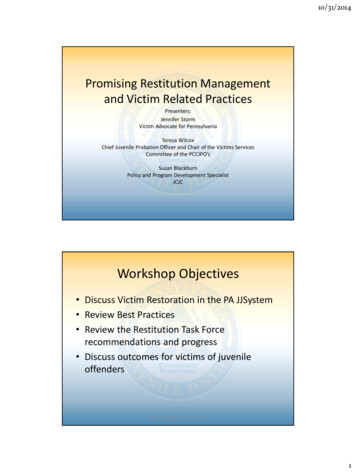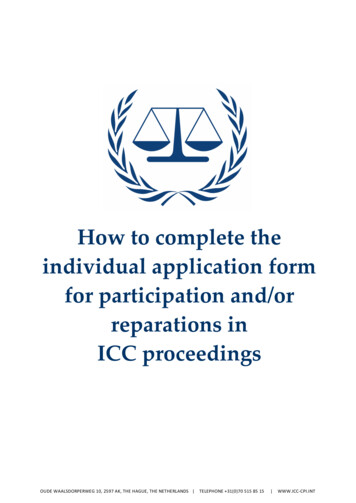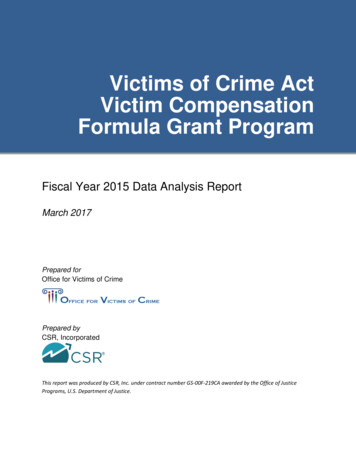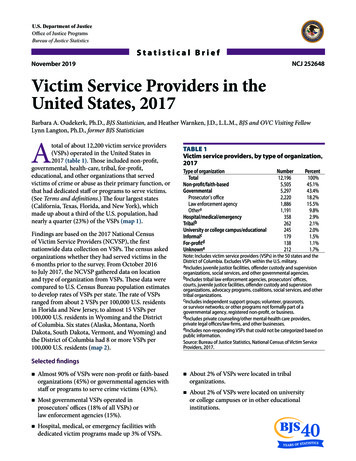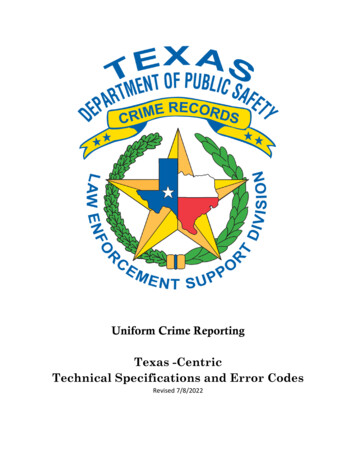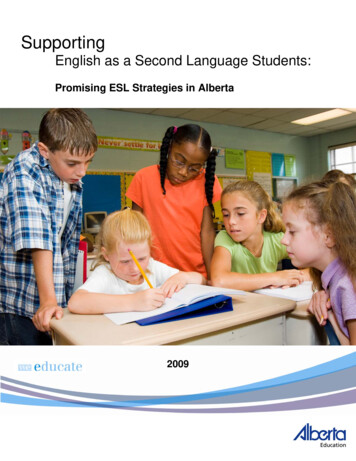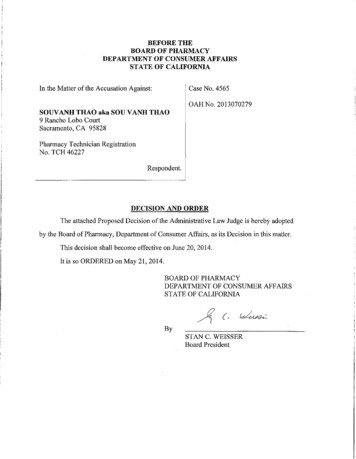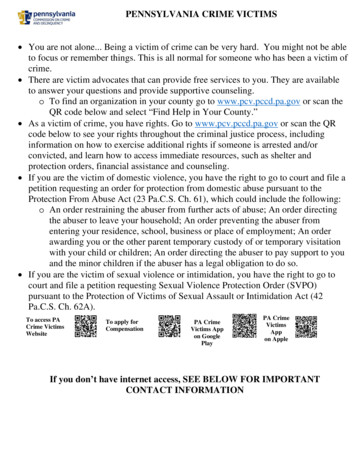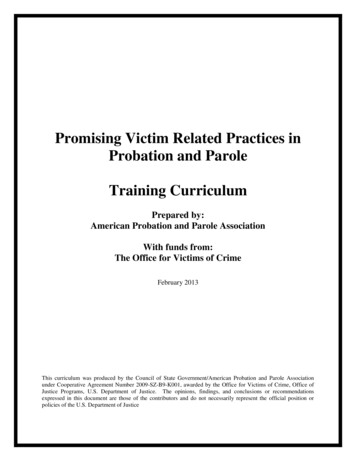
Transcription
Promising Victim Related Practices inProbation and ParoleTraining CurriculumPrepared by:American Probation and Parole AssociationWith funds from:The Office for Victims of CrimeFebruary 2013This curriculum was produced by the Council of State Government/American Probation and Parole Associationunder Cooperative Agreement Number 2009-SZ-B9-K001, awarded by the Office for Victims of Crime, Office ofJustice Programs, U.S. Department of Justice. The opinions, findings, and conclusions or recommendationsexpressed in this document are those of the contributors and do not necessarily represent the official position orpolicies of the U.S. Department of Justice
About this TrainingThis training curriculum was developed the Council of State Governments/American Probation and ParoleAssociation (CSG/APPA) with funds from the Office for Victims of Crime. Carrie Abner, APPA Research Associate,served as the project manager and coordinated the compilation of this training curriculum. The following individualsserved as the primary subject matter experts for individual modules contained in the curriculum:Anne SeymourNational Victim AdvocateModule 2: Communicating Effectively with Crime VictimsJill WestonParole Agent, California Department of Corrections and RehabilitationModule 3: Incorporating Victim Input throughout the Community Corrections ProcessAurelia Sands BelleExecutive Director, Durham Crisis Response CenterModule 4: Victim NotificationJulie BegoniaPrivate ConsultantModule 5: Enhancing Restitution Collection and ManagementTraining Goal & Learning ObjectivesThe goal of this training program is to provide community corrections officers with information on strategies they canuse to enhance their interactions with and services to crime victims. By the conclusion of this training participantswill be able to: Describe the impacts and implications of crime on its victims. Demonstrate skills for communicating effectively with crime victims. Identify 4-5 approaches for obtaining victim impact statements, and 3-4 appropriate types of information torequest through victim impact statements. List 4-5 points in the community corrections process that officers should provide notification to victims. Demonstrate 2-3 strategies for increasing restitution collection among supervisees.The Way the Training is OrganizedThe training is designed as a 2-day seminar to be delivered to front-line staff in community corrections agencies. Priorto the onsite training, participants should complete a one-hour online lesson on “The Role of Community Correctionsin Victim Services.” A transcript of this lesson is included in the instructor’s and participants’ manuals. The onsitetraining curriculum is divided into 5 modules: Module I: Welcome and Introductions Module II: Communicating Effectively with Crime Victims Module III: Incorporating Victim Input throughout the Community Corrections Process Module IV: Victim Notification Module V: Enhancing Restitution Management and EnforcementLesson plans for each module, handouts, and other supplemental materials are provided.Questions about this curriculum should be directed to:Carrie AbnerResearch AssociateAmerican Probation and Parole AssociationP.O. Box 11910Lexington, KY 40578Phone: 859-244-8031; Fax: 859-244-8001; Email: cabner@csg.org2 Instructors’ Manual American Probation and Parole Association
Training on Promising Victim Related Practices in Probation and ParoleTraining Purpose and Agenda[Location][Date]Training Goal: The purpose of this training program is to build capacity and enhance victim services incommunity corrections settings by training probation, parole and other community justice professionals onhow they can be more effective in their response to and provision of services to crime victims.Training Objectives: Describe the impacts and implications of crime on its victims. Identify the specific rights of victims, and describe the role of community corrections staff inimplementing victims’ rights. Demonstrate skills for communicating effectively with crime victims. Identify 4-5 approaches for obtaining victim impact statements, and 3-4 appropriate types ofinformation to request through victim impact statements. List 4-5 points in the community corrections process that officers should provide notification tocrime victims. Demonstrate 2-3 strategies for increasing restitution collection among supervisees.AGENDADay 18:00 – 8:458:45 – 9:509:50 – 10:0010:00 – 12:0012:00 – 1:151:15 – 3:303:30 – 3:453:45 – 5:00Module 1: Introduction and WelcomeModule 2: Communicating with VictimsBreakModule 2: Communicating with Victims (cont.)Break for LunchModule 3: Victim Input/ImpactBreakModule 3: Victim Input/Impact (cont.)Day 28:00 – 8:158:15 – 9:459:45 – 10:0010:00 – 11:4511:45 – 1:001:00 – 3:003:00 – 3:153:15 – 4:454:45 – 5:00Recap of Day 1Module 4: Victim NotificationBreakModule 4: Victim Notification (cont.)Break for LunchModule 5: Enhancing Restitution Collection and ManagementBreakModule 5: Enhancing Restitution Collection and Management (cont.)Closing & Evaluations3 Instructors’ Manual American Probation and Parole Association
Training to Improve Restitution Management in Community Corrections[Location] [Date]Faculty Information[customize as necessary]4 Instructors’ Manual American Probation and Parole Association
Training on Promising Victim Related Practices in Probation and Parole[Location][Date]Participant List[Customize for the jurisdiction]5 Instructors’ Manual American Probation and Parole Association
6 Instructors’ Manual American Probation and Parole Association
7 Instructors’ Manual American Probation and Parole Association
8 Instructors’ Manual American Probation and Parole Association
9 Instructors’ Manual American Probation and Parole Association
10 Instructors’ Manual American Probation and Parole Association
11 Instructors’ Manual American Probation and Parole Association
12 Instructors’ Manual American Probation and Parole Association
13 Instructors’ Manual American Probation and Parole Association
14 Instructors’ Manual American Probation and Parole Association
15 Instructors’ Manual American Probation and Parole Association
16 Instructors’ Manual American Probation and Parole Association
ModuleIWELCOME AND INTRODUCTIONSInstructor GuideInstructor ScriptLesson I: Welcome and IntroductionsPurpose of Lesson: To introduce and set the stage for the training program and clarifyparticipants’ expectations.Learning Objectives:By the conclusion of this lesson, participants will be able to: List the sponsors of and faculty for the training seminar. Recall the purpose of the training program. State their expectations for the training program. List ground rules for the training program.Equipment and Materials Needed: LCD projector/laptop and PPT slides (or Overhead projector with slides made intotransparencies) Chart pad, easel, markers, masking tape Handouts to include in the Participant Manualo Slides printed 3 per pageo Agendao Faculty contact information and biographical sketcheso Participant list17 Instructors’ Manual American Probation and Parole AssociationMediaActivitiesTimeTotal time:30 minutes
ModuleIWELCOME AND INTRODUCTIONSI. Welcome and Introductory RemarksWelcome everyone to the Training on Promising Victim-Related Practices inProbation and Parole seminar.LectureDisplay slide 1Introduce yourself and other faculty members by providing a brief overview of eachperson’s background, experience, etc.Display slide 2Inform participants the curriculum this training is based on was created by APPAwith funds from the Office for Victims of Crime.Display slide 3Provide a brief overview of the American Probation and Parole Association. Letparticipants know that APPA is a professional membership organization forcommunity correctional professionals and its membership is comprised ofprofessionals in the United States, territories and Canada. All levels of governmentincluding local, state/provincial, legislative, executive, judicial, and federal agenciesare counted among its constituents. As a membership organization it produces aquarterly journal, Perspectives; delivers specialized training programs and twoprofessional training institutes per year; and serves as a clearinghouse forinformation on issues of importance to community corrections.18 Instructors’ Manual American Probation and Parole AssociationA little about APPA Professional membership organization Community corrections professionals—both juvenile and criminal justice system Produces products, such as Perspectives Conducts professional training seminarsand Institutes Serves as an information clearinghouse Manages federally-funded grant projects8 minutes
ModuleIWELCOME AND INTRODUCTIONSIn addition to its membership services, the American Probation and ParoleAssociation (APPA) receives funds from federal agencies and private foundationsto conduct research and training projects on a variety of subject areas related tojuvenile and criminal justice issues. Typical products from research/grant projectsinclude program development and implementation guides, training curricula andmonographs, and the delivery of training seminars, audio and satelliteteleconferences, and technical assistance. Remind participants again that thistraining curriculum was developed and tested as part of a past OVC-funded project.If they want to get an idea of other types of projects we have and accessinformation, resources and training that may be provided through other grantfunded APPA projects, they can look on the APPA website (www.appa-net.org) fora listing of current (and past) projects.Display slide 4Provide a brief overview of the Office for Victims of Crime. The Office for Victimsof Crime (OVC) was established by the 1984 Victims of Crime Act (VOCA) tooversee diverse programs that benefit victims of crime. OVC provides substantialfunding to state victim assistance and compensation programs—the lifeline servicesthat help victims to heal. The agency supports trainings designed to educatecriminal justice and allied professionals regarding the rights and needs of crimevictims. OVC also sponsors an annual event in April to commemorate NationalCrime Victims Rights Week (NCVRW). OVC is one of five bureaus and fouroffices with grant-making authority within the Office of Justice Programs, U.S.Department of Justice. Acknowledge OVC’s contribution and support to thecommunity corrections field and crime victims through the funding of the projectthat resulted in this training curriculum.A little about OVC Established by the 1984 VOCA Oversees diverse programs that benefit victimsof crime Provides funding to state victim assistance andcompensation programs Supports training on victim issues to justiceprofessionals Sponsors NCVRW – every April One of 5 bureaus and 4 offices within OJP, DOJIf applicable, invite a representative from the hosting agency to provide a welcomemessage at this time (determine in advance if they want to do this and who will bemaking remarks). Thank the hosting agency for providing the support for thistraining to come to this area and acknowledge our happiness at being able toprovide this training today.II.Ground Rules and Logistics19 Instructors’ Manual American Probation and Parole AssociationMini lecture & class discussion5 minutes
ModuleIWELCOME AND INTRODUCTIONSExplain to participants that this training is designed to involve them in the learningprocess. Therefore, tell participants that before we proceed any further, there are afew ground rules that need to be established in order to make the session moreeffective and efficient.Write the following ground rules on a flipchart tear sheet and post on the wall (priorto class). Respect other participants’ ideas and input Participate actively Limit side discussions with table mates during lectures and class discussions Turn off cell phones (or place in vibrate/silent mode) Return promptly from breaksDisplay slide 5Ground Rules Respect others ideas and inputParticipate activelyLimit side discussionsTurn off (or silence) cell phonesReturn promptly from breaksOthers?After briefly reviewing the posted ground rules, ask participants if there are otherground rules they would like to see added to the list. If so, chart their suggestions.Provide a quick overview of the logistics for the training event (e.g., location ofbathrooms, places to eat, where participants can smoke, etc.).III.Training Purpose & Objectives and Participants’ExpectationsRefer participants to the overall training goal and objectives on the agenda includedin their Participant Manual. Explain the purpose of this training program is toprovide community corrections officers with information on strategies they can useto enhance their interactions with and services to crime victims. Briefly summarizethe training objectives and review the day’s agenda. Ask if they have any questionsor comments before proceeding.Briefly review how the Participant Manual is structured and explain how it can beused during the session (e.g., to take notes, activity sheets for exercises, handouts,etc.)Mini lecture & class discussionRefer to training agenda in theParticipant ManualIntroductions and ExpectationsRefer to Participant ManualDisplay slide 7Introductory Exercise: Explain to participants that you would like to learn about20 Instructors’ Manual American Probation and Parole Association30 minutes
ModuleIWELCOME AND INTRODUCTIONStheir thoughts and feelings about attending the training session by going around theroom and having each person:1. State their name,2. Indicate what they do for their agency,3. Answer the question, “By the end of this training session, I hope to learn ”Introductions and Expectations1. State your name2. Indicate what you do for your agency3. Answer the question:“By the end of this training seminar, Ihope to learn ”4. Best or craziest excuse for not payingrestitutionTo add some levity to the introductory exercise, you can also ask them to identifythe strangest thing that is currently in their refrigerator.Chart their responses related to their expectations. If no co-trainer is available, thistask can be assigned to a participant. This will help keep the process moving anddiscussion flowing easier.Inform participants they can repeat someone else’s answers if it expresses theirsentiments as well. Display slide 7 during the exercise as a reminder to participantsabout the information they need to provide during their turn. After everyone has aturn, briefly review the expectations of participants and identify the issues that willor should be covered in the day’s session. Also, identify expectations expressed byparticipants that are beyond the scope of the day’s presentation. If possible, makesuggestions on how they may seek that information through other venues (e.g.,websites, publications, follow-up meetings with agency staff, etc.).IV.ConclusionAsk participants if they have any questions or comments before we move to themore content-specific portion of the training. Respond to questions as needed.Question/AnswerDisplay slide 8Questions?21 Instructors’ Manual American Probation and Parole Association2 minutes
ModuleIWELCOME AND INTRODUCTIONSHandoutsandSupplemental ResourcesModule I(Welcome and Introductions)22 Instructors’ Manual American Probation and Parole Association
ModuleIWELCOME AND INTRODUCTIONS23 Instructors’ Manual American Probation and Parole Association
ModuleIWELCOME AND INTRODUCTIONS24 Instructors’ Manual American Probation and Parole Association
ModuleIWELCOME AND INTRODUCTIONS25 Instructors’ Manual American Probation and Parole Association
Module2COMMUNICATING EFFECTIVELY WITH CRIME VICTIMSInstructor GuideInstructor ScriptLesson II: Communicating Effectively with Crime VictimsLearning Objectives:By the conclusion of this lesson, participants will be able to: Explain the impact of trauma on victims of crime and its implications for ourinteractions and communications with crime victims.Differentiate between things that should and should not be said whencommunicating with victims.Demonstrate strategies for communicating with victims who are upset or angry.Discuss effective strategies for communicating with victims of crime.Equipment and Materials Needed: LCD projector/laptop/screen and PPT slides Chart pad, easel, markers, masking tape DVD Player, Television Handouts to include in the Participant Manual Challenges to talking to victims (activity sheet) Good and Bad things to say to victims (activity sheet) Good things to say to victims (list) My offender is back in the community (activity) Telephone skills checklist26 Instructors’ Manual American Probation and Parole AssociationMediaActivitiesTimeTotal time:3 hours,20 minutes
Module2COMMUNICATING EFFECTIVELY WITH CRIME VICTIMSInstructor ScriptInstructionalStrategies/MediaTimeSection: Overview and IcebreakerSection Outline and Instructor Notes:Review the four learning objectives Explain the impact of trauma on victims of crime and its implications for ourinteractions and communications with crime victims. Differentiate between things that should and should not be said whencommunicating with victims. Demonstrate strategies for communicating with victims who are upset or angry. Discuss effective strategies for communicating with victims of crime.20 mins.LEARNING OBJECTIVES,slide 1010APPALearning Objectives Explain the impact of trauma on victims of crime andits implications for our communications with them. Differentiate between things that should and shouldnot be said to victims. Demonstrate strategies for communicating withvictims who are upset or angry. Discuss effective strategies for communicating withvictims of crime.Tear Sheet (TS): AdditionalLearning ObjectivesASK: “Is there anything you’d like to learn from this session that is NOT included in these TS: Parking Lotobjectives?”KAISER QUOTATION, slideIf “YES:” Add to “Additional Learning Objectives” tear sheet11If it WON’T be covered: Add to “Parking Lot” tear sheet11Print out and tell about Cheryl Ward Kaiser’s family victimization in heryl-ward-kaiser.php“Victims remembertwo things:those who help,and those who hurt.”- Cheryl Ward KaiserCheryl has become an outspoken proponent of restorative justice and victim/ offenderdialogue.In community corrections, you want to be remembered for helping victims, and nothurting them.Please take three minutes to discuss, based upon your experiences, any challenges you27 Instructors’ Manual American Probation and Parole AssociationKaiser’s victimizationexperienceICEBREAKER, slide 12
Module2COMMUNICATING EFFECTIVELY WITH CRIME VICTIMS12face in talking to victimsAPPASmall Group ActivityICEBREAKERReporter to the full group is “the person who woke up earliest this morning”Facilitate full group discussion for five minutesWhat are some of theCHALLENGESyou face in talking to crime victims?Small Group Activity“Icebreak Activity”worksheetSection: Victims’ Stress, Crisis and Trauma28 Instructors’ Manual American Probation and Parole Association60 mins
Module2COMMUNICATING EFFECTIVELY WITH CRIME VICTIMSSection Outline and Instructor Notes:The National Crime Victim Research and Treatment Center at the Medical University ofSouth Carolina (http://colleges.musc.edu/ncvc/) is our Nation’s leading researchinstitution on victimology. Its rich body of research over the past 25 years has identifiedfive factors related to victim trauma and how it affects survivors’ interactions with thejustice system: Trauma can reduce victims’ willingness to participate in the CJS When trauma is recognized and addressed, it can improve cooperation It can also improve their perception of community corrections (and the victim’sperception is your reality!) Can reduce the “secondary trauma” that often results from having to think about,recall and speak about the crime Can improve victim input through things like PSIs and VISWHY SHOULD YOU BECONCERNED?, slide 13SMALL GRP ACTIVITY:VICTIMS CONCERNS, slide1414APPASMALL GROUP ACTIVITYMy offender is back in thecommunity, and I’mconcerned about?Divide participants into five groups, and pass out the worksheetInstruct them to take seven minutes to discuss “victims’ major concerns” for each of fivecategories on the worksheet, and prioritize the three most important concerns.“Victims’ Concerns” wrkshtFacilitate a report-out to the full group for ten minutesFive tear sheets, each with“concerned about ”written on the topVICTIM STRESSORS, slideVictim Stressors: Discuss the five stressors on this slide and ask: “What can YOU do to15possibly mitigate the victim’s stress?”Possible responses:Community Corrections and VictimStressors Treat him/her with respect Seeing the offender in court/release hearing (Re)thinking about the crime before dealing Validate any concerns the victim may havewith justice professionals Wondering if you’ll be believed and/orblamed Help identify the most important needs that can be addressed Not understanding the system Protection/safety issues Offer information that can be immediately helpful to the victimTear sheet: Mitigating29 Instructors’ Manual American Probation and Parole Association
Module2COMMUNICATING EFFECTIVELY WITH CRIME VICTIMSVictim StressorsTrauma Factors: Read the SlideTRAUMA FACTORS, slide16Factors that Affect Trauma Existing stressors in one’s life Past traumatic experiences, including priorvictimization Treatment by others (including family members,friends and justice professionals) Mental health and supportive servicesCRISIS THEORY, slide 17Crisis Theory: Read the slide and describe crisis theoryCrisis Theory Crisis characterized by high levels of subjectivestress and inability to modify source of stressthat produced crisis Can be produced by a variety of stressful lifesituations Dangerous/harmful situations most likely toprovoke a crisis reactionDefinition of Crisis: Read the definition of “crisis,” and note that Albert R. Roberts is aProfessor of Criminal Justice, Livingston College Campus, Rutgers, the State University ofNew Jersey; and a nationally-recognized expert in crisis and crisis theory.DEFINITION OF CRISIS,slide 18Definition of Crisis Crisis: “Temporary state of upset anddisequilibrium, characterized chiefly by anindividual’s inability to cope with a particularsituation using customary methods of problemsolving and by the potential for positive ornegative outcome.” (Roberts, 1995)30 Instructors’ Manual American Probation and Parole Association
Module2COMMUNICATING EFFECTIVELY WITH CRIME VICTIMSCOMMON IMMEDIATEREACTIONS, slide 19Immediate Crisis ReactionsDescribe immediate reactions: Terror and fear from the unexpected nature of being victimized Shock at the sudden, sometimes violent nature of the crime High anxiety that results from not being able to immediately cope with the crisis Victims can’t believe the crime is happening, AND happening to THEM Physiological arousal, where certain senses may kick in, i.e., heightened sense ofsmell, sight, touch, etc.Common Immediate Reactions TerrorShockHigh anxietyCan’t believe it has happenedPhysiological arousalCOMMON SHORT-TERMShort term trauma:REACTIONS, slide 20Short-term trauma is defined as that which occurs during or immediately after the crimeuntil about three months post-crime. This time frame for short- versus long-termCommon Short-term Reactionstrauma is based on several studies showing that most crime victims achieve significant High anxiety May or may not look distressedrecovery sometime between one and three months after the crime: Disturbed concentration Few crime victims are anticipating a violent assault at the time it occurs; so most areshocked, surprised, and terrified when it happens. Crime victims often have feelings of unreality when an assault occurs and think, “Thiscan’t be happening to me.” People who have been victimized in the past are at greater risk of developingemotional problems than newly victimized individuals. Victims do not “get used toit.” Many violent crime victims describe experiencing extremely high levels ofphysiological anxiety, including rapid heart rate, hyperventilation, and stomachdistress.31 Instructors’ Manual American Probation and Parole Association Concerns about safety Sleep disturbances Concerns about who to tell Concerns about being believed, and not beingblamed
Module2COMMUNICATING EFFECTIVELY WITH CRIME VICTIMS Crime victims often experience cognitive symptoms of anxiety including feelingterrified or helpless, guilty, out of control.REMEMBER, slide 2121Such physiological and emotional reactions are normal “flight or fight” responses thatoccur in dangerous situations. In the days, weeks, and first two or three months afterthe crime, most violent crime victims continue to have high levels of fear, anxiety, andgeneralized distress. The following are examples of distress that may disrupt violentcrime victims’ ability to concentrate and to perform simple mental activities requiringconcentration: They are preoccupied with the crime (i.e., they think about it a great deal of the time;they talk about it; they have flashbacks and bad dreams about it). They are often concerned about their safety from attack and about the safety of theirfamily members. They are concerned that other people will not believe them or will think that theywere to blame for what happened. Many victims also experience negative changes in their belief systems and no longerthink that the world is a safe place where they can trust other people and wherepeople get the things they deserve out of life. For victims of some crimes, like child abuse or domestic violence, the trauma occursmany times over a period of weeks, months, or even years. Victims in such casesoften experience the compounded traumatic effects of having to always worry aboutwhen the next attack will occur. (NVAA 2000 Text, Chapter 6.1)Say, “Time does NOT always heal all wounds, and if a victim has not received supportiveservices or (if needed) counseling, he or she may experience long-term reactions longafter the crime has occurred (which may be just around the time of their interactions32 Instructors’ Manual American Probation and Parole AssociationAPPAREMEMBER .The amount of time betweenwhen the crime occursand your interactions with victimsmay affect yourcommunications .
Module2COMMUNICATING EFFECTIVELY WITH CRIME VICTIMSwith YOU!)”It is helpful to determine:When the crime occurred Whether or not the victim has received any supportive services, including victimassistance and mental health counseling If the victim is experiencing any long-term trauma (see slide 15)Long Term RX and PTSD:The presenter should be familiar with crime-related PTSD; a brief overview is availablefrom the NCVC athttp://www.ncvc.org/ncvc/main.aspx?dbName DocumentViewer&DocumentID 32364LONG-TERM RX AND PTSD,slide 22Long-term ReactionsPTSD Person has been exposed to a traumatic event inwhich both of the following were present: Experienced, witnessed or was confronted with anevent or events that involved actual or threateneddeath or serious injury, or a threat to the physicalintegrity of self or others. The person’s response involved intense fear,helplessness, or horror.OTHER LONG TERM RX,slide 23Other Long-term PsychologicalResponsesLong-term, crime-related psychological trauma is not limited to PTSD. Compared topeople without a history of criminal victimization, those who have been victimized havesignificantly higher rates of major depression, panic symptoms, and substance use. Forexample, using National Women’s Study data from sexual and/or physical assaultvictims, Kilpatrick, Edmunds, and Seymour (1992) and Acierno, Byrne, Resnick, andKilpatrick (1998) found the following: One-third to one-half of assault victims develop depression. Risk of alcohol abuse is increased by a factor of 4. Risk of drug use is increased by a factor of 3.5. Ninety-five percent of a clinic sample with panic disorder had a victimization history.Seventy percent of treatment-seeking trauma victims reported four or more panicsymptoms.These findings have been identified in a number of studies including (Sorenson et al.1987; Atkeson et al. 1982; Ellis, Calhoun, and Atkeson, 1980; Kilpatrick, Edmunds, and33 Instructors’ Manual American Probation and Parole Association Depression Thoughts of suicide and suicide attempts Alcohol and other drug abuse Problems with relationships Changing view of the world: As a “safe place” Trust issues Seeking justice
Module2COMMUNICATING EFFECTIVELY WITH CRIME VICTIMSSeymour, 1992; Frank and Stewart 1984; Saunders et al. 1992). The following studieshave found these mental health problems as a result of criminal victimization: Thoughts of suicide (Kilpatrick et al. 1992; Saunders et al. 1992; Kilpatrick et al.1985). Attempting suicide (Kilpatrick et al. 1985; Kilpatrick et al. 1992; Saunders et al. 1992). Developing alcohol or other drug abuse problems (Burnam et al. 1988; Cottler et al.1992; George and Winfield-Laird 1986; Kilpatrick et al. 1994; Sorenson et al. 1987). Anxiety disorders such as panic disorder (Burnam et al. 1988; Saunders et al. 1992),agoraphobia (Burnam et al. 1988; Saunders et al. 1992), and obsessive compulsivedisorder (Burnam et al. 1988; Saunders et al. 1992).In addition to these mental disorders and mental health problems, violent crime oftenresults in profound changes in other aspects of the victim’s life. Many victimsexperience problems in their relationships with family and friends. Among therelationship problems they can experience is difficulty in sexual relations with theirpartner (Becker et al. 1982; Becker et al. 1986; Resick 1986; Saunders e
3 Instructors' Manual American Probation and Parole Association Training on Promising Victim Related Practices in Probation and Parole Training Purpose and Agenda [Location] [Date] Training Goal: The purpose of this training program is to build capacity and enhance victim services in community corrections settings by training probation, parole and other community justice professionals on
